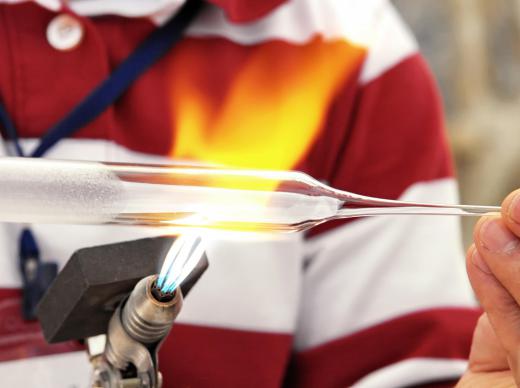What is an Amorphous Solid?
An amorphous solid is any material which does not have its molecules arranged in a lattice, or crystalline structure. Amorphous solids are relatively rare, making up only 10 percent of solids in the world. The most well known example of an amorphous solid is glass, and in fact, these solids are sometimes generally termed glasses.
The three states of matter — solid, liquid, and gas — occur because of the varying degrees of movement of the molecules that make up the substances. Molecules and atoms in gases have a wide range of movement, spreading out because the molecules are weakly linked together. Liquids have a more restricted range of movement, yet their molecules still move freely within those confines, changing position. This freedom is what gives liquids their lack of permanent shape.

Molecules in solids, on the other hand, are bound together with no real freedom of movement. The molecules still shift, however, oscillating in their bonds. The oscillating movement is what allows solids to heat up. The faster the molecules shake in their bonds, the hotter the object gets.
In crystalline solids, which make up 90 percent of the solids in the world, molecules are bound in an ordered patterned. This ordered pattern repeats exactly throughout the entire structure, creating a lattice of molecules. Conversely, an amorphous solid may have a repeating pattern for small portions of its make-up, but not for its entirety.
Amorphous solids may be made natural or man-made. Lightning striking sand will naturally cause glass to form at its strike point. Commercial glass, however, is man-made, using a process that creates the same conditions as lightning, but in a controlled environment. In addition to glass, one of the most widely used amorphous solids is plastic. Plastic is made from polymers, long strings of molecules purposefully chained together.
Additionally, amorphous solids can be made out of crystalline solids. For example, glass is made from quartz sand, a crystalline solid. The sand is heated to extreme temperatures, which effectively melts it, and then cooled quickly, or supercooled, so the molecules do not have time to arrange themselves back into a lattice form. This supercooling results in a molecular arrangement of the glass similar to if someone had taken a snapshot of the liquid.
Since amorphous solids' structures appear similar to liquids, they are sometimes called supercooled liquids. This similarity is also why the myth developed that glass is actually a slowly-moving liquid. Additionally, unlike a crystalline solid, an amorphous solid does not immediately liquefy when exposed to heat, but instead grows increasingly soft.
AS FEATURED ON:
AS FEATURED ON:











Discussion Comments
@pleonasm - I wonder if that theory has got something to do with the fact that one of the conditions in the definition of an amorphous solid is that is has to soften rather than become a liquid when it is heated.
One of the reasons glass is such a good art material is that it softens like this when it is heated, so it can be blown into thin and lovely shapes, rather than needing to be poured into a mold or hammered into shape like metals are.
I also really like the shapes that lightning makes with glass, which are sometimes refined and then sold as glass art. One of the characters in Sweet Home Alabama (the movie) did this, although the sculptures they showed as his lightning sand creations don't really look like what this really looks like.
I had always liked the idea that glass was actually a liquid that moved so very slowly that it might as well be solid. But I had read somewhere that it's not true. The thing that people often use as evidence of this is that in ancient monasteries and other buildings where the original glass is still present, the glass often looks much thicker at the bottom. They use this as evidence that the glass has gradually been "settling" at the bottom of the frame.
The real reason for this though is that back in the day they used to have more primitive ways of making glass, so inevitably it wouldn't be flat and one side would have a thicker edge. It only made sense to put the thicker edge at the bottom of the frame so it would take the weight.
It is nice to find out that glass is a special kind of amorphous material but still kind of a shame that it isn't entirely a liquid.
Post your comments